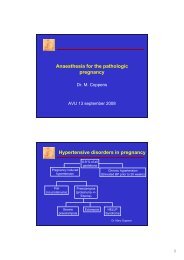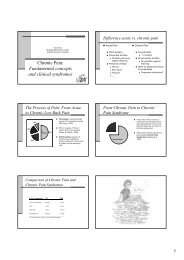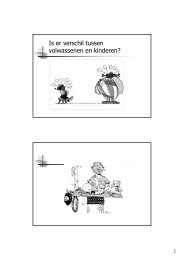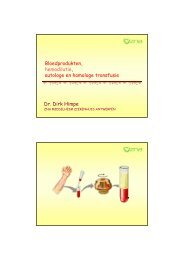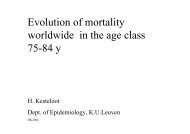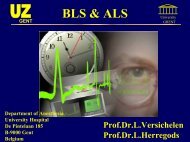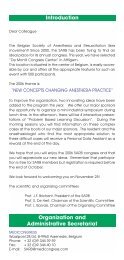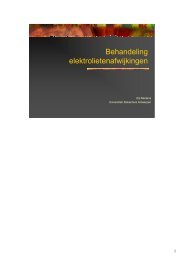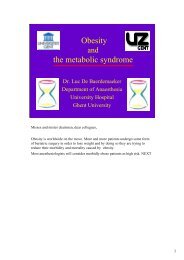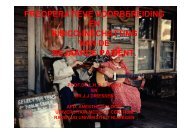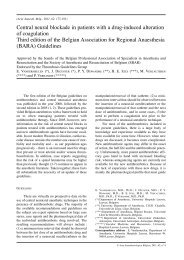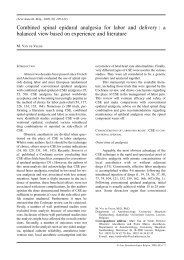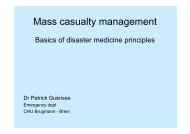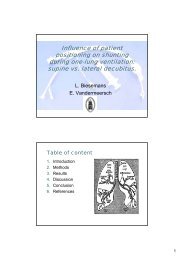Postoperatieve complicaties, exclusief respiratoire
Postoperatieve complicaties, exclusief respiratoire
Postoperatieve complicaties, exclusief respiratoire
You also want an ePaper? Increase the reach of your titles
YUMPU automatically turns print PDFs into web optimized ePapers that Google loves.
Post-Operatieve Complicaties<br />
(<strong>exclusief</strong> <strong>respiratoire</strong>)<br />
Dr. Caroline Vanlersberghe<br />
Dienst Anesthesiologie<br />
UZ-Brussel<br />
Vrije Universiteit Brussel<br />
Ontwaken uit Anesthesie<br />
Luchtwegobstructie<br />
g<br />
Rillen<br />
Nausea en braken<br />
Agitatie, confusie of delirium<br />
Pijn<br />
Hypothermie<br />
Labiliteit autonoom zenuwstelsel<br />
1
Factoren die Impact hadden op<br />
PostAnesthesie Zorgen<br />
Creatie van specifieke zone voor observatie en<br />
behandeling van patient na anesthesie/heelkunde<br />
Ontwikkeling gespecialiseerde nursing voor<br />
onderkennen van specifieke <strong>complicaties</strong> tijdens de<br />
onmiddellijke postoperatieve periode<br />
Identificatie en beschikbaarheid van anesthesioloog<br />
voor medisch beleid PACU<br />
Standaardnormen en -procedures voor PACU<br />
Speciale zorgeenheden voor specifieke populaties<br />
(low/high/pediatric care/extended observation unit)<br />
De Low-Care Afdeling<br />
2
De Pediatrische Observatie<br />
Procedure voor PACU-Opname<br />
Onstabiele fysiologie bij ontwaken vereist<br />
maximum veiligheid<br />
• controleplicht bij installatie patiënt<br />
Nut PACU Admission Report<br />
Noodzaak adequaat postoperatief<br />
behandelingsplan en informatie over potentiële<br />
klinische <strong>complicaties</strong><br />
Delegatie verantwoordelijkheid naar PACU-VP:<br />
pas wanneer hemodynamische, ventilatoire en<br />
luchtwegenstatus stabiel<br />
3
PACU Admission Report<br />
Preoperatieve anamnese<br />
• allergie/allergische reacties<br />
• medische pathologie<br />
• laatste chronische medicatie<br />
• acute problemen (ischemie,<br />
deshydratatie, zuur-base)<br />
Intraoperatieve factoren<br />
• heelkunde, type anesthesie<br />
• spierrelaxantia/antagonisten<br />
• onverwachte heelk./anesth.<br />
Gebeurtenissen<br />
• vitale tekens, labo’s,<br />
urinedebiet,bloedverlies<br />
• perfusies, medicaties<br />
• opioiden (tijd, dosis)<br />
Evaluatie huidige status<br />
• HR, BD, T°, ventilatie<br />
• bewustzijnsniveau<br />
• positie ET-tube<br />
• monitoring, catheters (epidurale,<br />
invasieve)<br />
• Algemene indruk<br />
<strong>Postoperatieve</strong> instructies<br />
• geanticipeerde problemen<br />
(hemodynamisch, ventilatoir, labotesten,<br />
RX, urinedebiet)<br />
• aanvaardbaar bloedverlies<br />
li<br />
• therapeutische orders, positie<br />
• therapeutische eindpunten vóór<br />
ontslag<br />
Taak van de PACU<br />
Medische supervisie en coördinatie patiëntenzorg<br />
Observatie en bewaking van vitale functies en<br />
psychische toestand van de geopereerde patiënt<br />
Specifieke bewakingstechnieken (hart- en<br />
longfuncties)<br />
Bijstand en sturing van oxygenatie, ventilatie,<br />
circulatie en lichaamstemperatuur<br />
Diagnose en accurate behandeling van<br />
postoperatieve <strong>complicaties</strong><br />
4
Ontslagcriteria<br />
Algemene conditie<br />
• geöriënteerd (tijd, persoon, ruimte) en volgt<br />
instructies<br />
• huidskleur : geen cyanose, vasoconstrictie, bleekheid<br />
• goede spierkracht en mobiliteit voor minimale<br />
zelfzorg<br />
• controle postoperatief nausea en braken<br />
Cardiovasculaire status<br />
• HR, BD binnen 20% van preoperatieve waarden<br />
• stabiele cardiovasculaire status sinds minstens 30<br />
min<br />
• afwezigheid van dysritmie en myocardischemie<br />
• aanvaardbare intravasculaire volume status<br />
Ontslagcriteria<br />
Luchtwegenstatus<br />
• beschermende reflexen intact<br />
• geen stridor, partiële obstructie of retracties (geen<br />
mayo)<br />
Ventilatie en oxygenatie<br />
• 10 30 ml/u, evaluatie hematurie,<br />
glycosurie<br />
5
Ontslagcriteria<br />
Postoperative pijncontrole<br />
• aangepast niveau van analgesie (onrust,<br />
nausea/braken, sedatie, ademhalingsdepressie)<br />
• observatie sinds laatste dosis narcoticum<br />
• 30 min indien IV of perifere PCA<br />
• 60 min indien IM, SC, epidurale PCA<br />
Ambulante patiënten<br />
• rondwandelen zonder duizeligheid, steun of<br />
hypotensie<br />
• inname oraal vocht getolereerd<br />
• spontane mictie (?)<br />
Ontslagcriteria Neuraxiale<br />
Anesthesie<br />
Risico : instabiliteit autonoom zenuwstelsel<br />
• hypotensie, bradycardie<br />
Regressie sensorieel blok T10, motoriek tenen<br />
• geen garantie voor hemodynamische stabiliteit<br />
Orthostatische test (Alexander et al, Anesthesiology 1989)<br />
• BD liggend en zittend<br />
• 2 testen 30 min apart<br />
• MAP < 10% preoperatieve waarde<br />
6
Probleemstelling PACU<br />
Hoge doorstroming van patiënten in beperkte<br />
ruimte<br />
Mix van patiënten met verschillende<br />
conditionerings- en stabilisatieproblemen<br />
Verwikkelingen anecdotisch gerapporteerd<br />
• Hemodynamische incidenten : meest frequent<br />
• Respiratoire <strong>complicaties</strong> : meest significante morbiditeit<br />
PACU Situaties met Morbiditeit<br />
Respiratoir<br />
• hypoventilatie, luchtwegobstructie<br />
Hemodynamisch<br />
• aritmie, bloeddrukwijzigingen, ischemie<br />
Nausea en braken<br />
Hypothermie<br />
Ontwaakdelirium<br />
Pijn<br />
7
<strong>Postoperatieve</strong> Pijn<br />
Patiënt gebonden factoren<br />
• Leeftijd<br />
• Preoperatieve persoonlijkheid<br />
• Psychologische voorbereiding<br />
Anesthetische factoren<br />
• Preoperatieve medicatie<br />
• Gebruikte anesthetica en techniek<br />
Heelkundige factoren<br />
• Lokalisatie<br />
• Uitgebreidheid<br />
• <strong>Postoperatieve</strong> <strong>complicaties</strong><br />
Respiratoire Bewaking<br />
Luchtweg obstructie :<br />
• farmaca : sedatie, spierhypotonie, areflexie<br />
• weerslag : hypoventilatie, mucusevacuatie, bronchospasme,<br />
atelectase, aspiratie, acuut longoedeem<br />
Residuele curarisatie / anesthetica :<br />
• laryngeale incompetentie, V/Q stoornissen<br />
Type heelkunde: hoofd, hals, thorax, abdomen,<br />
wervelzuil (atelectasen)<br />
Pijn : narcotica, CZS depressie<br />
8
Pulsoximetrie<br />
Transport naar PACU<br />
• 35% patienten t S p O 2 < 90% (P a O 2 60 mmHg)<br />
• 12% patienten S p O 2 < 85% (P a O 2 50 mmHg)<br />
• Kinderen : cyanose aanwezig in < 50% met desaturatie<br />
• O 2 toediening tijdens transport<br />
Continue bewaking S p O 2<br />
Ontslag uit PACU : geen relatie PAR scores<br />
en oxygenatie<br />
• voor ontslag : S p O 2 92-96% met lucht 10-15 min<br />
• zo negatief : transport naar zaal met O 2<br />
Hemodynamische Functie<br />
Training : BD, CVD, PAD<br />
Risicofactoren :<br />
• hypertensie, cardiovasculaire pathologie<br />
• ASA, ouderdom, heelkunde<br />
• dringendheid heelkunde<br />
• <strong>respiratoire</strong> dysfunctie, agitatie en pijn<br />
Nut van grenswaarden?<br />
9
Cardiovasculaire Problemen<br />
Hypotensie<br />
Hypertensie<br />
• hypovolemie<br />
• pijn<br />
• hypoxie<br />
• hypoxie, hypercarbie<br />
• afname autonome<br />
tonus<br />
•<br />
•<br />
blaasdistentie<br />
perifere<br />
•<br />
•<br />
overdosering<br />
medicatie<br />
low output failure<br />
•<br />
vasoconstrictie<br />
intracraniele<br />
heelkunde<br />
• majeure vasculaire<br />
heelkunde<br />
Therapie: O 2 + behandel oorzaak<br />
Hypotensie<br />
‣ Absolute hypovolemie (reductie circulerend intravasculair volume)<br />
→↓ ventriculaire vulling en CO<br />
→<br />
SZS-gemedieerde tachycardie, ↑ SVR en venoconstrictie kunnen<br />
compenseren voor 15-20% verlies intravasculair volume.<br />
Oorzaak: preoperatief vochtdeficiet, per-en postoperatief bloed en<br />
vochtverlies (bloeding, zweten, exsudatie (3de ruimte)<br />
Cavé: in hypotherme, venogeconstrikteerde patiënt kan laag<br />
intravasculair volume CO behouden doch hypotensie veroorzaken als<br />
veneuze capaciteit toeneemt door opwarmen.<br />
Relatieve hypovolemie (normaal intravasculair volume)<br />
‣ Plotse ↓ SZS activiteit door pijnbestrijding of vasovagale respons →↑<br />
veneuze capaciteit<br />
‣ Medicatie α-adrenerge blockade (droperidol), histamine release<br />
(morfine) of directe veneuze dilatatie ( furosemide, nitraten)<br />
‣ Spinale of epidurale anesthesie (interferentie SZS)<br />
‣ Compressie thoracale venen tgv PPV<br />
‣ Compressie v cava inferior: zwangerschap, ↑ intra-abdominale druk<br />
10
Hypotensie<br />
Ventriculaire dysfunctie<br />
• Excessieve vocht administratie → dilatatie ventrikel,<br />
↓ CO en hypotensie, vaak x hydrostatisch<br />
longoedeem<br />
• Sympathisch blok gedurende epidurale of spinale<br />
anesthesie behandeld met excessieve<br />
vochttoediening<br />
→ ventriculaire vullingsdrukken normaal tijdens<br />
ondanks hypervolemie<br />
→ Na opklaren blok: SZS outflow mobiliseert grote<br />
vochtvolumes naar centrale circulatie → ventriculair<br />
falen<br />
Hypotensie<br />
‣ Myocardiale ischemie<br />
‣ Cardiale dysrhytmia<br />
‣ Sinus of nodale bradycardie (
<strong>Postoperatieve</strong> Hypertensie<br />
↑ Sympatische activiteit<br />
• Schadelijke stimuli:<br />
• Pijn, angst, craniële stimulatie, volle blaas, ET<br />
• Nadelige fysiologische condities:<br />
• Hypercarbia/acidosis, hypoxemia, hypotensie,hypolycemie,<br />
congestief hartfalen, ↑ intracraniële druk,myocard ischemie<br />
• Medicatie:<br />
• β-mimetische pressoren, ephedrine, isoproterenol, epinephrine<br />
• Dopamine, dobutamine<br />
• Brochodilators, terbutaline,aminophylline<br />
• Antihypertensiva: hydralazine, nitroprusside<br />
• Anesthetics:<br />
• Ketamine, isoflurane<br />
↓ Parasympatische activiteit<br />
• Medicaties:<br />
• Parasympatholytica: atropine, glycopyrrolaat<br />
• Spierrelaxantia: pancuronium<br />
Cardiovasculaire Problemen<br />
Tachycardie<br />
• pijn<br />
• orthosymp. stimulatie<br />
• hypovolemie<br />
• hypotensie<br />
• hypoxemie<br />
• koorts<br />
• endotoxine shock<br />
Bradycardie<br />
• spinale / epidurale<br />
• hypothermie<br />
• toename ICP<br />
• atleet<br />
• residueel effect van<br />
neostigmine, β-blokker<br />
12
Bradycardie<br />
↑ Parasympatische activiteit<br />
• Vagale reflexen:<br />
• Carotis sinus massage, valsalva maneuver, kokhalzen, rectaal<br />
onderzoek, ↑ oculaire druk, blaas distentie, faryngeale stimulatie<br />
• Parasympathomimetische medicatie:<br />
• Acetylcholinesterase inhibitor: neostigmine, edrophonium<br />
• Alfa-adrenerge farmaca: neosynephrine, norepinephrine<br />
• Opioiden: morphine, fentanyl, sufentanil, alfentanil, remifentanil<br />
• Succinylcholine<br />
↓ Sympatische activiteit<br />
• Hoge spinale of epidurale anesthesie<br />
• Wegnemen van stimulus, extubatie, blaaslediging<br />
• Zware acidemie/hypoxemie<br />
• Sympatholytische medicatie:<br />
• Beta-receptor blokkers (propranolol)<br />
• Opioiden/sedativa/algehele anesthesie<br />
• Ganglion blokkers<br />
• Lokale anesthetica<br />
Myocard Ischemie<br />
Risicofactoren<br />
• Gekende coronaire pathologie, congestief<br />
hartfalen, perifeer vaatlijden<br />
• Ongecontroleerde hypertensie<br />
• Ouderdom<br />
• Beperkte inspanningstolerantie<br />
• Chronische nierinsufficiëntie<br />
• Linker ventrikel hypertrofie<br />
• Gebruik van digoxine<br />
• Diabetes mellitus<br />
13
Dynamische predictoren<br />
Tachycardie<br />
Hypotensie<br />
Hypertensie<br />
Hypoxemie<br />
(ventilatie,<br />
anemie, 2,3 DPG)<br />
Silent<br />
myocardial<br />
ischemia<br />
Autonome<br />
dysfunctie<br />
(stress, pijn, shivering<br />
ontwaak delirium)<br />
Hypercoagulabiliteit Coronair spasme<br />
Afname fibrinolyse<br />
Myocard Ischemie<br />
Prognose<br />
• <strong>Postoperatieve</strong> ischemische ECG veranderingen<br />
in 41% der patiënten<br />
• 9-voudige toename van risico op cardiale<br />
morbiditeit<br />
Mechanismen<br />
• Toename myocard O 2 consumptie > O 2 aanvoer<br />
• Adrenerge stress, tachycardie, pijn<br />
• Vasoconstrictie<br />
14
Myocard Ischemie<br />
Anemie/ hypothermie bij risicopatiënten<br />
• Hct 30 %<br />
• Correctie hypothermie: ΔT –1.2°C verdubbelt<br />
hartdebiet<br />
Therapeutische benaderingen<br />
• β-adrenerge blokkers<br />
• α 2 -adrenerge agonisten: verminderen<br />
noradrenerge transmissie in CZS;<br />
veroorzaken sedatie, anxiolyse en analgesie<br />
• Coronaire vasodilatatie door thoracale<br />
epidurale<br />
Hypothermie<br />
Weerslag op <strong>respiratoire</strong>, cardiale, CZS,<br />
hepatische en renale systemen<br />
• hypoxie, acidose, toename zuurstofverbruik<br />
• Δ T - 1.2°C verdubbelt hartdebiet<br />
• vertraagd metabolisme van farmaca<br />
• stoornissen van coagulatie<br />
Verlenging verblijfduur PACU<br />
• Verwarming en humidificatie gassen (vermindert<br />
verblijfsduur met 30%)<br />
15
Gevolgen Perioperatieve<br />
Hypothermie<br />
Medicatie voor behandelen<br />
Postanesthetie “Shivering”<br />
16
Hyperthermie en<br />
Temperatuurbewaking<br />
maligne hyperthermie : 1/50.000 (volw), 1/15.000 (kind)<br />
hyperthyroide crisis : 2 - 8% hyperthyroide vrouwen, 30-40 j<br />
pheochromocytoom : 0,1-0,5% van hypertensieve patienten<br />
Voorafbestaande infecties: sinusitis, urineweginfectie , URI<br />
sepsis : 20% evolueert naar septische shock<br />
reacties op medicaties : colloiden, antibiotica, neuroleptica,<br />
antihypertensiva, cimetidine<br />
reacties op bloed en bloedcomponenten<br />
cerebrale catastrofen : hemorragie, tumor, trauma<br />
braken en aspiratie<br />
exogene hyperthermie : atropine (kind), afdekmateriaal<br />
Veranderde Mentale Status<br />
Ontwaak reacties<br />
• Normaal ontwaken<br />
• Kort na ontwaken: onvermogen sensorische input<br />
normaal te verwerken; somnolentie, lichte<br />
desoriëntatie, vertraagde mentale reacties; doch dit zal<br />
snel verdwijnen<br />
• Stormachtig ontwaken belangrijke medische gevolgen:<br />
• Trauma: contusie of fraktuur; cornea abratie; tractie op<br />
sutuur: sutuur loslating, vasculaire enten, drains,<br />
vasculaire katheters etc<br />
• Tachycardie, hypertensie, verhoogde sympatische tonus<br />
17
Dysfunctie van CZS<br />
Psychomotorische excitatie<br />
• tachycardie, onrust, desoriëntatie,gewijzigde<br />
pijnperceptie, irrationeel gedrag<br />
• Frequent bij kinderen en jonge patiënten<br />
<strong>Postoperatieve</strong> confusie en agitatie<br />
• Ethiologie:<br />
• Alcohol abusus<br />
• Intraoperatief gebruik anticholinergica,<br />
benzodiazepines en barbituraten<br />
• Hypoxemie<br />
• Blaasdistensie<br />
• Acute pijn hypovolemie<br />
Dysfunctie van CZS<br />
‣ Delirium<br />
• Oudere patiënten (5-50%)<br />
• Wijzigingen in geheugen, perceptie, denken en cognitieve<br />
functies, frequent bij ouderlingen<br />
• Cerebrale hypoxie: meest frequente oorzaak<br />
Steeds eerst opsporen en behandelen !<br />
• Medicamenteuze oorzaken: ketamine, anticholinergica<br />
(atropine, scopolamine), propofol<br />
• Bestaande afwijkingen: dementie, gehoors-enen visus<br />
problemen<br />
• Electrolytstoornissen, endocriene afwijkingen, sepsis<br />
• Hypotensie en cerebrovasculaire pathologie<br />
18
Stormachtig ontwaken<br />
• Ingreep met emotionele implicaties<br />
• Intraoperatieve awarness of recall → angst, paniek<br />
• Ontwenningsreacties (alcohol, opioïd, cocaïne of andere<br />
drug verslaving)<br />
• Pijn →↑ agitatie, confusie en aggressief gedrag<br />
• Urinaire of gastrische distentie<br />
• Te strak aangespannen verbanden<br />
• Slechte positionering<br />
• Residuele paralysis: → agitatie of ongecoördineerde<br />
bewegingen<br />
Verlengd Ontwaken uit Anesthesie<br />
Hypoventilatie na inhalatie anesthesie<br />
Distributie/afbraak van IV anesthetica<br />
Residuele sedatieve, anesthetische en<br />
analgetische medicatie effecten<br />
Hypothermie (≅ 33°C)<br />
Hypoxemie, hypercarbie<br />
Hyponatremie, hyperCa<br />
2+ /Mg<br />
2+<br />
Hypo- of hyperglycemie<br />
Neurologische pathologie<br />
19
Importance PONV<br />
Weakness<br />
8%<br />
Frissons<br />
8%<br />
Somnolence<br />
Throat 3%<br />
intubation<br />
3%<br />
Sonde<br />
17%<br />
Memorisation<br />
14%<br />
Nausea<br />
12%<br />
Vomiting<br />
18%<br />
Pain<br />
17%<br />
Macario, Anesth Analg 1999; 89: 652-8<br />
for 30% avoidance of PONV is the biggest concern<br />
they are willing to spend up to $100 for an effective antiemetic<br />
Postoperatief Nausea en Braken<br />
Discomfort patiënt<br />
Aspiratie pneumonie<br />
Electrolyt stoornissen (kinderen)<br />
Wond ruptuur<br />
Vertraagd ontslag uit PACU<br />
Multimodale behandeling<br />
20
Factoren die PONV Veroorzaken<br />
Opioiden<br />
CTZ Anesthetica<br />
CTZ<br />
Farynx<br />
Vomiting Center<br />
Pijn<br />
Vestibulair<br />
Gastro-intestinaal<br />
Hypotensie<br />
Psychologisch<br />
Anti-emetica<br />
Zeneca<br />
21
Identificatie<br />
Apfel et al.1999: SIMPLIFIED RISK FACTOR CHART<br />
Female sex 1<br />
‣ Non-smoking status 1<br />
‣ History of PONV / 1<br />
Motion Sickness<br />
‣ Post-operative use 1<br />
of opioids<br />
Sum of risk factors 0 till 4<br />
80<br />
70<br />
60<br />
50<br />
40<br />
30<br />
20<br />
10<br />
0<br />
79<br />
61<br />
39<br />
21<br />
10<br />
0 1 2 3 4<br />
PONV Flow diagram<br />
Patient factors<br />
Female sex<br />
History of PONV<br />
or motion sickness<br />
Non-smoker<br />
Postoperative opioid use<br />
Surgical factors<br />
Laparoscopy<br />
Laparotomy<br />
Plastic surgery<br />
Major breast surgery<br />
Craniotomy<br />
Otolaryngologic procedures<br />
Strabismus surgery<br />
Mild to moderate risk Moderate to high risk Very high risk<br />
20-40%<br />
40-80%<br />
>80%<br />
1-2 factors present<br />
3-4 factors present<br />
>4 factors present<br />
Any one of the following<br />
Droperidol<br />
Dexamethasone<br />
Scopolamine<br />
Serotonin antagonist<br />
Droperidol plus<br />
Serotonin antagonist<br />
Or<br />
Dexamethasone plus<br />
Serotonin antagonist<br />
Combination antiemetics<br />
Plus<br />
Total intravenous<br />
Anesthesia with propofol<br />
Gan TJ 2002 JAMA<br />
22
Abnormale Urine Output<br />
Oligurie: < 0.5 ml/kg/u:<br />
• Anatomische obstructie urine flow (postrenaal)<br />
• Primaire renale aandoening (intrarenaal)<br />
• ↓ CO, hypotensie of low intravasculair volume (perenaal)<br />
• ↑ ADH<br />
Polyurie:<br />
• Excessieve intraveneus volume toediening<br />
• Diabetes insipudus, hyosthenuria (sikkel-cel anemie) , renale<br />
concentratie deficieten<br />
• Postobstructieve diuresis (hoge BUN spiegels: osmotische diurese<br />
x tubulaire dysfunctie tgv obstructie)<br />
• Hyperglycemie, mannitol: osmotische diuretica<br />
Haematuria:<br />
• RBC, hemoglobinurie (intravasculaire hemolyse), myoglobinuria<br />
(rhabdomyolysis)<br />
Renale Complicaties<br />
Blaasretentie na spinale of epidurale blok<br />
Renale tubulaire functie:<br />
• Urine:<br />
• kleur geen indicatie concentratie vermogen<br />
• Hematurie, hemoglobinuria, pyuria<br />
• Urine osmolariteit : > 450 mOsm/L<br />
(concentratievermogen intact)<br />
• Urine Na + conc < serum conc, K + conc >serum K +<br />
Anorganisch Fluoride tgv metabolisatie inhalatie<br />
anesthetica (Sevoflurane) → transiënte ↓<br />
tubulairconcentrerend vermogen, ev ATN<br />
23
Blaasretentie of globus<br />
24
Bloedende patiënt<br />
Bloeddrukval is niet noodzakelijk aanwezig<br />
tijdens initiële faze haemorrhagische shock<br />
• Intense VC vnl bij jongere patiënten kan<br />
compenseren voor verloren bloedvolume zodat<br />
bloeddruk niet valt (10-15% = 750 ml)<br />
• Jonge patiënten kunnen tot 15-30% van<br />
bloedvolume verliezen (± 1500ml) voor bloeding<br />
levensbedreigend wordt (↑ tonus SZS)<br />
• Andere tekenen van ontwikkelende shock:<br />
• Tachycardie, oligurie (< 1 ml/kg/u), “poor<br />
perfusion status” met koude handen<br />
Metabole Complicaties<br />
Respiratoire Acidemia<br />
Metabole acidemia<br />
Respiratoire alkalemie<br />
Metabole Alkalemie<br />
25
Metabole Complicaties<br />
Hyperglycemie<br />
• Stress , glucose infuus<br />
• Matige postop hyperglycemie (150-250mg/dl) verdwijnt<br />
spontaan<br />
• > 250 mg/dl → glucosuria met osmotische diurese<br />
• Zware hyperglycemie: →↑serum osmolaliteit →<br />
hyperosmolaar coma<br />
• Diabetes mellitus → insuline deficiëntie, risico ketoacidosis<br />
Hypoglycemie<br />
• Endogene insuline secretie, of exogene insuline toediening<br />
• Therapie: 50% dextrose gevolgd door glucose infuus<br />
Electrolyten stoornissen<br />
Hyponatremie:<br />
• Vrij water iv infuus of Na + -vrije irrigatie vloeistoffen<br />
(TURP, hysteroscopie)<br />
• Onaangepaste ADH secretie, langdurige arbeid inductie<br />
met oxytocine → vrij water retentie<br />
• Symptomen:<br />
• agitatie, disorientatie, visuele stoornissen, nausea<br />
• Zware hyponatremie: bewustzijnsverlies, gestoorde<br />
luchtwegreflexen, CZS irritabiliteit (Grand mal)<br />
• Therapie: IV normaal fysiologisch i zout en furosemide<br />
26
Electrolyten stoornissen<br />
Hypokaliëmie<br />
• Dysrhytmia vnl x digoxin<br />
• Oorzaak:<br />
• chron diuretica, nasogastrische aspiratie, braken<br />
• Urinaire en hemorrhagisch verlies, dilutie, insuline therapie x<br />
<strong>respiratoire</strong> alkalemie<br />
• Calcium infuus, beta-mimetica, ↑ SZS activiteit →↑ effect van hypokaliemie<br />
Hyperkaliëmie<br />
• Overdreven K + infuus, nierfalen, maligne hyperthermie<br />
• ↑ door acute acidemia<br />
• Succinylcholine x brandwonden, zware trauma, chronische neurologische<br />
schade<br />
• Therapie: IV insuline en glucose, IV calcium gaat myocardiale effecten<br />
tegen<br />
Calcium en magnesium<br />
Verlengd neuromusculair blok<br />
Excessief gebruik NMB<br />
Metabole en electrolyt afwijkingen<br />
Zuur-base stoornissen<br />
Leveraandoeningen met ↓ klaring<br />
Nierfalen : ↓ drug excretie<br />
Hypothermie: ↓ metabolisme en excretie<br />
Hypokaliëmie, hypocalcemie, hypermagnesemia en metabole<br />
alkalosis : verlengen effect NMB<br />
Respiratoire acidosis inhibeert werking NMB antagonisten<br />
Aminoglycosiden, gy furosemide, lidocaïne potentiëren effect<br />
NMB<br />
Pseudocholinesterase deficientie: succinylcholine, mivacurium<br />
• Zwaar leverlijden, malnutritie, zwangerschap, plasmaferesis<br />
Neurologische aandoeningen motoreindplaat<br />
27
Onvoorziene trauma<br />
Oculaire letsels en visus stoornissen<br />
• Cornea abrasio:<br />
• uitgedroogd of vreemd voorwerp in oog<br />
• frequenter bij oudere patiënten, langdurige ingreep, laterale<br />
of ventrale decubitus, na hoofd en hals heelkunde<br />
• Veroorzaakt tranen, ↓ visus scherpte, fotofobie<br />
• Geneest spontaan binnen 72 u<br />
• Soms cataract, visus stoornissen tot gevolg<br />
• Visuele scherpte gestoord na anesthesie<br />
• Autonome neveneffecten medicatie storen accomodatie en<br />
residuele oog bevochtigers storen gezicht<br />
• Stoornis retinale perfusie door oogcompressie: →<br />
postoperatieve visuele stoornissen gaande van verlies scherpte<br />
tot permanente blindheid<br />
• Ischemische n opticus atrofie zonder externe compressie: ↑<br />
risico na lang ingreep in voorovergebogen positie of bij<br />
vasculair lijden<br />
Gehoorsproblemen<br />
• Vaak subclinisch, ↓ auditieve scherpheid, tinnitus, of<br />
ronken<br />
• Incidentie detecteerbare gehoorsstoornis<br />
• Hoog na durale punctie (8-16%)<br />
• Functie van naalddikte<br />
• Leeftijd patiënt<br />
• Uni- of bilateraal<br />
• Verdwijnt spontaan<br />
• Na algehele l anesthesie<br />
• Tgv disruptie rond venster of ruptuur tympaan<br />
• Inflammatie buis van Eustachius en otitis sec aan ET<br />
28
Orale, faryngeale of laryngeale letsels<br />
Laryngoscoop blad, heelkundig instrumentarium, rigiede<br />
luchtwegen, tanden → trauma orale weke weefsels→ ijs zakjes<br />
Traumatische intubatie → hematoma en oedeem → partiële<br />
bovenste luchtwegobstructie → nebulisatie van epinefrine<br />
verbetert stridor<br />
Schade aan de tanden → documenteer, cave vreemd voorwerp<br />
aspiratie<br />
Heesheid en keelpijn na ET : 20-50% ; ook na LMA , aspiratie<br />
• Mucosale irritatie tgv droogte en lokale anesthetica<br />
Laryngoscopie → n hypoglossus en n laryngeus recurrens<br />
schade, stemband schade, ulceratie, trachea perforatie<br />
Zenuwletsels<br />
Slechte positionering gedurende anesthesie<br />
• Ruggemerg letsel tgv hematoom na regionale anesthesie<br />
• Perifere zenuw compressie → soms permanent sensorisch of motorisch<br />
deficiet alsook stretch letsels door hyperextensie ledematen<br />
Postdural puncture headache (PDPH)<br />
• Na moeilijke subrachnoidale punctie met meerdere pogingen<br />
• Na accidentele dura punctie bij plaatsen epidurale<br />
• Subarachnoidale luchtbellen tgv loss-of-resistance testing kunnen bijdragen<br />
• Therapie: hydratatie, analgetica, bedrust<br />
• Eventueel epidurale bloed patch<br />
Zelden zenuwletsel tgv naaldcontact of intraneurale injectie<br />
• Horlocker et al: 6.3% op 4767 patiënten ondervonden paresthesieëntijdens<br />
rachi plaatsing; 0.126% persisterende symptomen<br />
• Focale gevoelloosheid, pijn, residuele paresthesia, dysesthesia<br />
Tijdens recovery na rachi anesthesie: ongemak onderste ledematen,<br />
pijn in billen, tekenen van sacrale of lumbale neurologische irritatie ;<br />
vnl na lithotomie positie, lidocaïne 5%<br />
29
Weke weefsels en gewrichten<br />
Drukpunten tijdens lange ingreep → ischemie en<br />
necrose weke weefsels<br />
• Alopecia, inflammatie, necrose<br />
Thermale, electrische en chemische brandwonden, door<br />
cauterisatie en ontsmettingsmiddelen<br />
Extravasatie van IV medicatie → gelokaliseerde<br />
chemische neuropathie, compartiment syndroom<br />
Excessieve gewrichts- of spierextensie → postop<br />
rugpijn, gewrichtspijn, stijfheid en zelfs<br />
gewrichtsinstabiliteit<br />
Spierpijn: fasciculaties tijdens depolariserende<br />
spierblokkade → myalgia<br />
Standaard PostAnesthesie Zorgen<br />
Zuurstoftherapie en aerosols<br />
Algemeen comfort en veiligheidsaspekten:<br />
risico patientenletsels, elektrocutie<br />
huidzorgen (elektrodenpasta)<br />
mond- en oogzorgen (cornea letsels)<br />
vaso-vagale reacties<br />
mobilisatie ledematen (passief en actief)<br />
opwarming<br />
psychologisch comfort<br />
30
Standaard PostAnesthesie Zorgen<br />
Intraveneuse therapie<br />
vocht- en electrolytoplossingen<br />
additionele medicaties, spuitpompen<br />
bloed en derivaten: transfusiereakties<br />
Adequate pijntherapie<br />
Bewakingsapparatuur<br />
minimum ECG, BD, S a O 2<br />
Klinische monitoring, incl. ademhaling en<br />
bewustzijn<br />
Observe, reassure and monitor<br />
Een verwarde, geagiteerde en<br />
rusteloze patiënt is hypoxisch tot<br />
het tegendeel bewezen is<br />
Behandel de patiënt en niet de<br />
p<br />
monitor<br />
31



